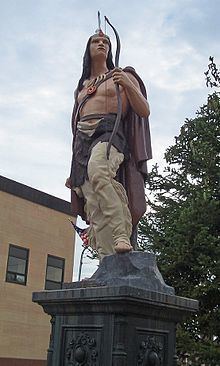Country United States ZIP codes 49849, 49865 Elevation 429 m Population 6,532 (2013) | State Michigan Time zone Eastern (EST) (UTC-5) FIPS code 26-41220 Local time Wednesday 8:48 PM Area code 906 | |
 | ||
Weather -6°C, Wind NW at 11 km/h, 47% Humidity | ||
Country village rv park ishpeming michigan a tour with drivin vibin
Ishpeming /ˈɪʃpəmɪŋ/ is a city in Marquette County in the Upper Peninsula of the U.S. state of Michigan. The population was 6,470 at the 2010 census. This is down from a higher population in the 1950s and 1960s when the economically supportive iron ore mines employed more workers. A statue of a Native American figure, erected in 1884 in the small town square, is referred to as "Old Ish".
Contents
- Country village rv park ishpeming michigan a tour with drivin vibin
- Map of Ishpeming MI 49849 USA
- Ishpeming michigan wmv wmv
- Geography
- 2010 census
- 2000 census
- Highways
- Airport
- Bus
- Rail
- Historical events
- Climate
- Notable people
- Points of interest
- Education
- Places of worship
- Festivals and events
- References
Map of Ishpeming, MI 49849, USA
Ishpeming Township is located to the northwest of the city but is administratively autonomous. Ishpeming is considered the birthplace of organized skiing in the United States and is the home to the National Ski Hall of Fame. The city was also prominently featured in the 2010 documentary Catfish.
The name Ishpeming comes from the Ojibwe word ishpiming, meaning "above", "in the air" or "on high".
Ishpeming michigan wmv wmv
Geography
According to the United States Census Bureau, the city has a total area of 9.35 square miles (24.22 km2), of which 8.74 square miles (22.64 km2) is land and 0.61 square miles (1.58 km2) is water. Ishpeming's elevation is 1,436 feet (438 m) above mean sea level, which is over 800 feet (240 m) higher than that of nearby Lake Superior. The highlands of Ishpeming and the surrounding area, including the city of Negaunee to its east, receive an unusually high yearly average of lake effect snow.
2010 census
As of the census of 2010, there were 6,470 people, 2,824 households, and 1,664 families residing in the city. The population density was 740.3 inhabitants per square mile (285.8/km2). There were 3,149 housing units at an average density of 360.3 per square mile (139.1/km2). The racial makeup of the city was 96.0% White, 0.2% African American, 1.1% Native American, 0.3% Asian, 0.1% from other races, and 2.2% from two or more races. Hispanic or Latino of any race were 1.0% of the population.
There were 2,824 households of which 28.3% had children under the age of 18 living with them, 42.0% were married couples living together, 12.2% had a female householder with no husband present, 4.7% had a male householder with no wife present, and 41.1% were non-families. 33.9% of all households were made up of individuals and 13.4% had someone living alone who was 65 years of age or older. The average household size was 2.23 and the average family size was 2.85.
The median age in the city was 40.3 years. 21.7% of residents were under the age of 18; 8.9% were between the ages of 18 and 24; 25.1% were from 25 to 44; 27.3% were from 45 to 64; and 17% were 65 years of age or older. The gender makeup of the city was 48.2% male and 51.8% female.
2000 census
As of the census of 2000, there were 6,686 people, 2,915 households, and 1,757 families residing in the city. The population density was 769.8 per square mile (297.1/km²). There were 3,210 housing units at an average density of 369.6 per square mile (142.6/km²). The racial makeup of the city was 97.29% White, 0.06% Black, 1.20% Native American, 0.19% Asian, 0.27% from other races, and 0.99% from two or more races. Hispanic or |Latino of any race were 0.81% of the population. 25.5% were of Finnish, 14.4% Italian, 14.1% English, 12.4% French, 7.3% German, 5.7% Swedish and 5.1% Irish ancestry according to Census 2000. 95.8% spoke English and 1.9% Finnish as their first language.
There were 2,915 households out of which 27.7% had children under the age of 18 living with them, 43.8% were married couples living together, 12.3% had a female householder with no husband present, and 39.7% were non-families. 34.0% of all households were made up of individuals and 15.2% had someone living alone who was 65 years of age or older. The average household size was 2.25 and the average family size was 2.89.
In the city, the population was spread out with 23.2% under the age of 18, 9.2% from 18 to 24, 26.9% from 25 to 44, 21.8% from 45 to 64, and 19.0% who were 65 years of age or older. The median age was 39 years. For every 100 females there were 89.6 males. For every 100 females age 18 and over, there were 87.1 males.
The median income for a household in the city was $31,347, and the median income for a family was $38,924. Males had a median income of $36,310 versus $21,104 for females. The per capita income for the city was $16,946. About 8.0% of families and 11.1% of the population were below the poverty line, including 15.5% of those under age 18 and 6.8% of those age 65 or over.
Highways
Airport
Bus
Rail
Historical events
Climate
This climatic region is typified by large seasonal temperature differences, with warm to hot (and often humid) summers and cold (sometimes severely cold) winters. According to the Köppen Climate Classification system, Ishpeming has a humid continental climate, abbreviated "Dfb" on climate maps.
Notable people
Points of interest
Education
Ishpeming Public School District No. 1 consisting of:
In the adjacent Ishpeming Township, the N.I.C.E. Community Schools consists of
